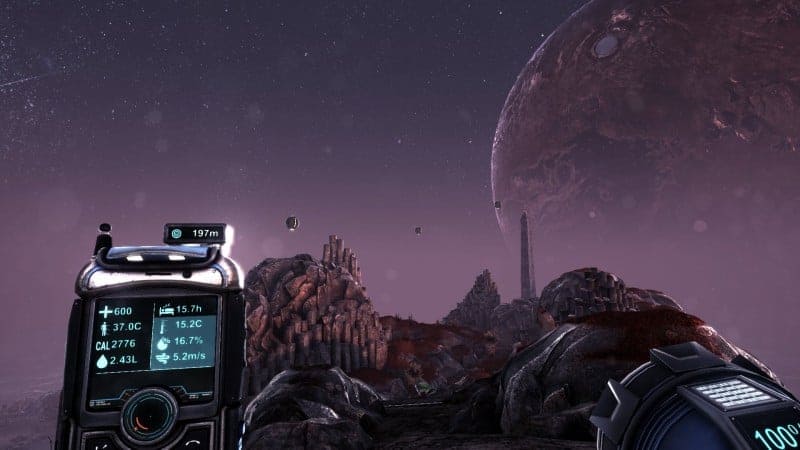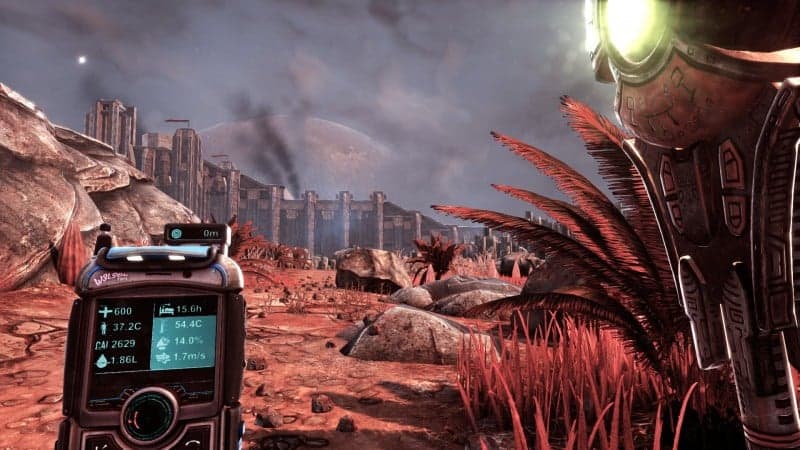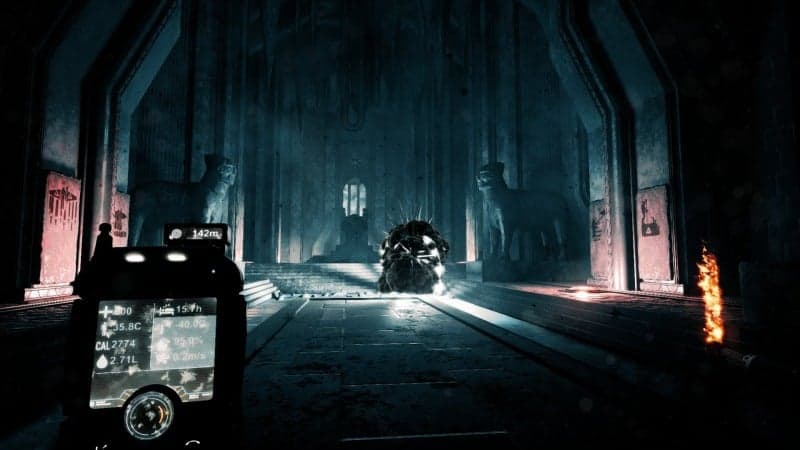Today’s review comes straight to us from Teotl Studios and Grip Digital, their newest release The Solus Project (PS4/PSVR $19.99). The game is for the PlayStation 4 and PSVR so that means that this game is right up my alley. Does this mysterious first-person adventure game satisfy in PSVR or does it fair better in standard play? Is the game even worth picking up at all in the first place? Don’t worry, I go over everything in this review of the new game, The Solus Project.
As traditional for my reviews, I have a mood-setting trailer for you for the game.
Furthermore, I have the whole description and feature list:
‘FULL DESCRIPTION
The Solus Project a single player exploration-driven adventure with survival elements, set on a mysterious and seemingly uninhabited alien planet. Survive through exploration, and unlock the mysteries of Gliese-6143-C.
Earth has been destroyed and mankind lingers on in a small fleet of ships near Pluto. As humanity’s last hope, you are sent to scout a distant planet as a potential location for a colony. After years of space travel disaster strikes, however, your ship is destroyed when approaching the planet…
With your team members dead and your equipment gone you have no way of communicating or receiving help from anyone… you are completely and utterly alone…
Desperately you look for a way of phoning home, but as you explore the seemingly desolate planet, you uncover the dark secrets buried within the depths. In this otherworldly odyssey you uncover mystery upon mystery as you try to survive the harsh climate.
KEY FEATURES
Explore – Unlock the depths of the uncharted planet, and discover the secrets buried deep below. Delve into huge cave systems and tombs and uncover over 200 secrets.
Vast handcrafted world – 10 large entirely handcrafted levels to explore. Explore and puzzle your way through 5 islands and 5 large tombs/caves.
Fully dynamic environment – An alien day and night cycle and a dynamic weather system that calculates everything from temperature, wind, humidity, cloud coverage impact on the climate and so on. It handles ocean tides. Plants respond to the climate. Storms form. Earthquakes happen.
Survive – Survive the extreme climate, tornadoes, storms, meteors, lightning… and the dark secrets buried beneath the surface.
PlayStation®VR support – Explore every corner of the vast and alien world in VR.’
Audio and Soundtrack:
This game has their audio flawless. I really have to give them credit overall. They even took things like explosions in space to a more accurate level. We always see in other media and games that when there are space battles you hear the shooting and the explosions when in all rationality, you shouldn’t hear it. There is zero air. There is no way to convey the sound to our ears. This game features a large explosion early on in a cutscene and instead of it being loud like those other mediums, they took a different route. They didn’t simply make it completely silent either because I think they realized that people would assume that the game is broken or glitching. They settled on the middle ground which is to have the most muffled explosion sound that only lasted for about 3 seconds and then petered off. It’s like it was reminding us that space has no air and the only air that could let sound be created is the air from within the vehicle that exploded, so there would be a flash of sound and then it would disappear. Perfectly chosen on their part.
Obviously, if they got that right, they nailed down everything else in terms of sound effects. They gave us new sounds that we had never heard since we were experiencing things that we have never seen. Anyone who reads my reviews knows that that is something that I love. All in all, I don’t really think we need to dwell much more on the audio aspect. We can move onto the music, which, as you can guess, also does not disappoint. The music is definitely different then other games that I’ve played. There was a small sense of that music that you get in Star Trek that invokes the feeling of exploration. But since the exploration of this game was borne out of the idea that it was mandatory and urgent, you also feel it in the music. The wonderful compounding of fear, exploration, wandering, and openness can all be found in the compositions. I’m not certain who it was that wrote the music, but I felt every purpose that they tried to convey while I was wearing my headphones and playing in VR mode.
There is a sense of it that is lost even when you’re playing in standard mode with surround sound on. You’d basically have to have it up pretty loud as you play, but make certain to reduce the bass through your subwoofer. Otherwise, you may find that the floor vibrates like crazy (I live in an apartment with neighbors below). I think that the audio and soundtrack play well with each other. It’s like I’ve set out to do a task and there is a soundtrack for it everywhere I go. 8/10
Visuals:
The Solus Project’s visuals seem to vary depending on the settings. If you’re playing Standard mode, they look great, and even better on a PS4 Pro. If you’re in VR mode, it seems to look better if you leave all of the settings on default rather than the settings that I mention down in the VR Reflections section. I very much leaned into the Standard mode as it brought to the table the visuals that I like to see when playing a game on a current gen console. If you watched the trailer or pay attention to the pictures in this review, you’ll see that the lighting is fantastic. They have a dynamic lighting system as well as a functioning day and night cycle. The shadows work flawlessly as well, versus those you might have in a previous generation game. The visuals go beyond as well in terms of weather. There is every weather type that we have here on earth that might be deemed dangerouns and man, they are convincing. You don’t want to be in the way of a mondo tornado!
Since there is a VR mode built into this game, you will find that it very much feels like 2 entirely different games. I’ve read that the team that ported it made the best decisions that they could after assessing all options and limitations of the hardware. I would say if you’re looking for the best visuals for the VR mode, play only on a PS4 Pro. You’re going to get back what you lose not playing in Standard mode. The textures are just so much richer and that sense of realism is that of what you might find in Resident Evil 7 for instance. If you’re worried or dislike the visuals of the VR mode, I would almost advise you to upgrade to a PS4 Pro. This isn’t the only game that has pushed the boundaries of what the hardware can do, and it certainly won’t be the last. 7/10
Gameplay:
This part is difficult. The game has so much stuff that you can actually do and so many hidden bits to it. I suppose what I can focus on is the core gameplay and what it takes to really move forward in this game. Those who played the other versions of the game, like on XBOX One, may have found the crafting simply too easy. However, I would argue in the PSVR playthrough, it helped the player so much to have that as navigation and button presses are harder to achieve. So if you’re looking for a greater difficulty instead of a breeze, you may very well defer to the PSVR mode. In fact, most PSVR experiences are anywhere from less than an hour to 3ish hours. This game can be beaten in 15 hours in PSVR if you’re just doing the bare minimum. Now that is truly bonkers,dear reader. I was thinking that a fair amount of that time was due to the fact that you have zero map as the traveler. I understand that there is no map because you’ve never been there before, but maybe a feature that creates a map as you go? Come on developers, add that into a patch please!
But back to the basics. It’s not enough just to explore and craft in this game. There is very much a survival angle involved here. You have to stay dry or if you get wet, you should stay warm. There’s definitely hypothermia and so many other real-world issues that can get you into trouble and kill you. In fact, it shares that in common with games like The Legend of Zelda: Breath of the Wild. You carry a PDA around that breaks down the elements and environment around you at all times. You can carry a tool in the right hand, this tool could be a torch or maybe something to strike/leverage an object open. It’s really all of the cave exploration and secret digging that really makes you want to spend more time in this game. No, there does not appear to be any fighting and no, it’s not a horror game. It’s all very basic at its core, but expansive and elaborate in what you truly get to do in the game. It’s just such a hard game to explain (really you truly should play it yourself to know everything).
The load screens are long, by the way, I had to add that in. You’ll be forced to look at random screenshots a fair amount as it has no loading bar to load a level in VR as it does have in the Standard mode. It will have a loading bar on its way to cutscenes though, but those are few and far between. Overall, even though the loading screens make take forever and not tell you how long it will be that you have to wait, they rarely happen, so that should put your mind at ease.
Replay-ability:
This game is long. This game is very long. This game is so long that if you explore everything about it, you’ll be in the 30 hour mark and even one of the developers said you probably shouldn’t spend 30+ hours in this game on PSVR. They want you to experience the game as it is, closer to a movie than a book. You’re just supposed to follow the beaten path, but it feels like it’s a new path. In terms of replay-ability though, I would say the best way you’re going to maximize your value here is to first play it in Standard mode. This way you know what all functions you have, how the world works, where things generally are. After you’ve beaten the game in that fashion, then move onto PSVR as an extra tasty morsel. But other than playing the game twice through, there really isn’t much more to it. You can’t really speedrun it in VR mode and there is no logical way for leaderboards and there definitely is no online multiplayer. It’s just you and a planet and that’s not necessarily a bad thing, but it just is not an infinite game. 5/10
VR Reflections:
I had the hardest time with the VR in this game. I followed instructions that I found from the developer online on how to have maximum comfort while playing to also enjoying the gameplay. However, upon applying those tweaks, sure I wasn’t having motion sickness, but I truly wasn’t having as good of a time as I have in other VR experiences. There is plenty to give them an A+ on here though. They have implemented so many options and modifiers for you to mix and match with that there should be some option that works the best for your comfort level. I would say that if you never get motion sickness, leave the default options how they are. If you’re American there are some non-VR options on the main menu though that you may not catch that you want to enable, like using Fahrenheit and having US measurements enabled.
Like I said, if you can leave the settings as they are, you’re a badass and you will be able to experience the game in its full-fledged glory. If you have a sensitive stomach as I do and you understand that you’ll have some concessions on gameplay and visuals, then play with the options until you’ve found an experience that works the best for you. You’ll just have to do more work in game, but it’s the same massive world at your disposal. Nothing is lost except visuals and you gain extra steps that you have to do in order to complete certain tasks. And, to answer the first question I posed at the top of this page, which is better Standard or VR play? Well, I would say for my money you get a damn decent experience with no issues on Standard mode (even better on PS4 Pro). PSVR should be for those who really love to dive deep into games and be a part of them. But I would say that it simply is not necessary for the gameplay to play in VR. 6/10
If you’re wanting The Solus Project for PSVR, you can download the game by clicking here.
Stay tuned here on Hackinformer.com and follow us on Twitter @Hackinformer
If you like the author and his work follow him on Twitter as well @V1RACY







